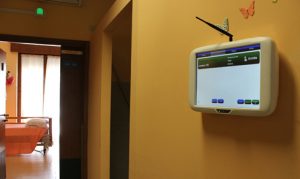For the first time in Italy, in the Residenza Anziani Villa San Bernardo in Parma, a completely wireless nurse call system was installed.
A completely wireless Legrand call system, distributed by BTicino, was chosen for the technological update – strictly non-invasive – of Villa San Bernardo, in Parma, active for 34 years, together with the other structures of the Diocesan Opera San Bernardo degli Uberti, with the aim of “guaranteeing dignity, improving the quality of life and maintaining, as far as possible, the autonomy of the elderly who live the most difficult phase of their lives.”
Within a nursing home, the use of call systems is very important, ie the buttons located next to the hospital beds. Villa San Bernardo, of course, already had a call facility. However, the solution dates back to the 1980s and showed various limitations. The management was looking for a more modern and effective solution that did not require a series of building works, which would have required the movement, for some weeks, of part of the guests. Hence was born the market research of an easier installation solution. The answer came with a completely new product for Italy: the Aid Call system, a totally wireless solution, developed by Legrand, for calling in medicalized environments.

The Aid Call radio signals propagate on the 868Mhz frequency, and cover a theoretical 70 meter radius around each individual antenna. The Aid Call antennas create a mesh network, allowing the signal, in case of physical obstacles, to propagate through paths recalculated by the platform in a dynamic manner. In correspondence to each bed present in the departments of the two floors affected by the works, for a total of 19 rooms, a call keypad with wire connection was thus placed. Unlike wired solutions, the patient terminal to which the push-button panel is connected has no power supply and, therefore, simply installed on the wall. Inside each one there are common batteries, with an average life of three years, which power the wireless transmission system and the communication display. This enabled the call system to be installed in each room using only two plugs. With a degree of protection IP 67, completely washable and made with material treated with antimicrobial agents, the buttons are phosphorescent, easily identifiable even at night.

The assistance staff, when operating following a call, presses the button to confirm the arrival and then the conclusion of the intervention. Such a solution avoids the useless rushing of more people to the same bed. The same solution, although in a simplified version, was installed in the bathrooms. Finally, above the door of each room there is a light signal with a multicolored light, which allows to identify, even visually, the room from which a call started and the type of call. Through the main 15” display (Touchsafe Pro), the staff can identify where a call comes from, the relative priority level and the position of the colleagues on duty, thus ensuring timely intervention.

Another interesting feature of Legrand’s Aid Call system is the possibility of integrating signals from medical equipment to which guests are connected through programmable contacts. In this way, in the event of an alarm or failure of the equipment itself, personnel are immediately alerted by a high priority signal also on the control panel.
www.bticino.it
www.legrand.it
A wireless target for BTicino at Villa San Bernardo
You are here:
- Home
- A wireless target for BTicino…

